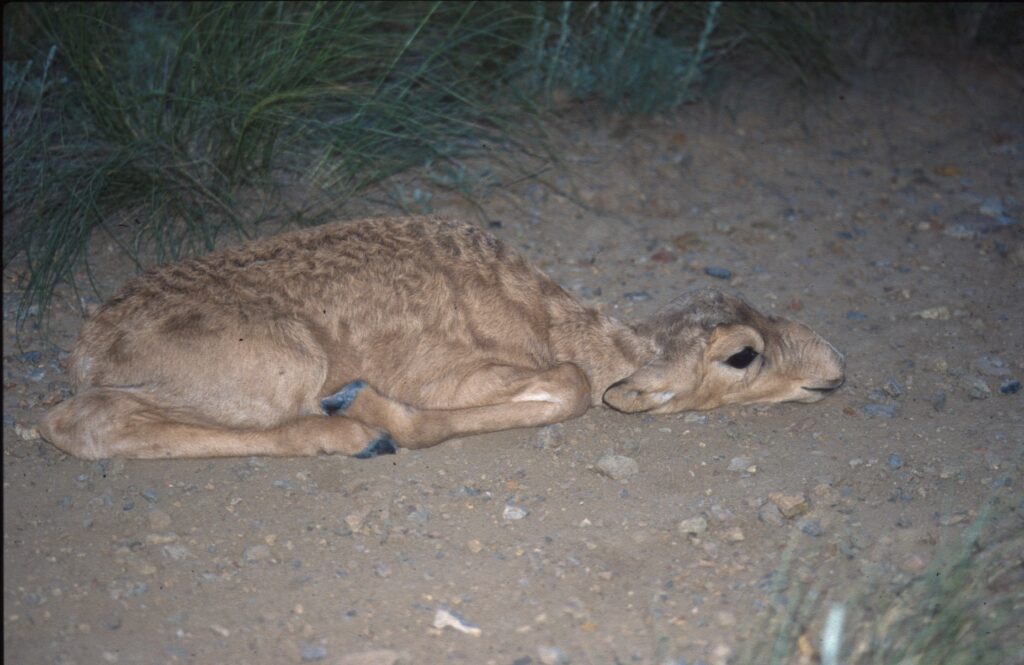University of Oxford
11a Mansfield Rd
OX1 3SZ
UK

With so much bad news it can be easy to let the good news slip by and focus on the many challenges that conservationists face. But it’s important to celebrate and share our successes, and also to share insights about what lies behind them so that we can learn together; that’s a key tenet of the Conservation Optimism movement, of which the Saiga Conservation Alliance is a member.
This week, the happy news came that the saiga antelope has changed IUCN Red List status from Critically Endangered (the highest level of threat) to Near-Threatened. For me this is particularly special because I have been working on saiga conservation for more than 30 years, having fallen in love with the species since I saw my first baby saiga on a dirt track in the vast wilds of Kazakhstan (pictured below).

This change in status is a massive jump towards safety (bypassing Endangered and Vulnerable on the way), only mirrored by the jump in the opposite direction, from the then equivalent of Near-Threatened to Critically Endangered, twenty years ago. So what happened, and what can we learn?
The saiga was a victim of geopolitical upheaval. When the Soviet Union collapsed, the borders with China opened, giving a route out for its horns for use in Traditional Asian Medicine. At the same time funding for conservation collapsed, as did the rural economy. People turned to illegal killing of saigas for food and for profit. This caused the species’ numbers to collapse – from an abundant keystone species of the Eurasian steppe numbering in the low millions to just a few thousand – a >90% decline in less than 10 years, catapulting it into the Critically Endangered category.
In much of life, we expect quick results – and this is true of conservation too. Project funding usually runs for between one and three years, and often unrealistic goals are set expecting a quick reversal of fortunes for our species. But in reality, conservation involves hard graft, patience, diplomacy and collaboration, over decades. And so it was for saigas: after 20 years, with many ups and downs – including a catastrophic mortality event in 2015 that killed 2/3 of the global population of the species (and 88% of the population in which it happened) in just 2 weeks – we have finally reached the point when the species as a whole can be considered out of the danger zone. Here’s my take on how this happened.
Firstly the saiga’s biology and place in local culture have helped enormously. It’s a species that “runs hot” – as an adaptation to its harsh rangeland environment, it has evolved very high birth rates and natural high abundance, so it can recover from shocks very quickly, whether they be harsh winters, disease outbreaks or in this case heavy hunting. If it’s able to migrate without barriers, and is not disturbed by humans, then populations can recover quickly. This is evidenced by the population affected by the disease in 2015 exceeding its pre-disease population size only six years later. Its cultural and symbolic importance to the people who share the rangelands with it means that they are predisposed to caring for the species, if circumstances allow.
Secondly, coalition-building. In 2006 all the saiga range states came together under the umbrella of the UN Convention on Migratory Species (on which the saiga is listed) to agree a Memorandum of Understanding on the Conservation and Sustainable Use of saiga antelopes, with an action plan and work programme, updated every five years. I was initially sceptical – not another talking shop when we need action on the ground! – but over the next 15 years this MoU has transformed saiga conservation. All the main NGOs working on saigas (including the Saiga Conservation Alliance, which I chair) are collaborating organisations, and all the governments take this MoU seriously and report progress against it.
Over the time in which the MoU has been operating, the small community of saiga conservationists has met repeatedly. Over time, we have formed friendships and trust. Gradually, our community has moved closer together so that we collaborate rather than compete, including working closely with Governments as well as across borders. This has paid dividends, including bringing a new cohort of conservationists through the ranks to replace those of us who were there at the beginning, funding success, and large-scale collaborations such as the Altyn Dala Conservation Initiative. The Saiga Conservation Alliance has played its part, as a convening and networking organisation, providing a platform for the sharing of information and the joint production of technical advice.

Saiga experts gather for a technical meeting of the CMS MoU on saiga conservation, Vilm, Germany, 2019
Finally – persistence and good faith. It’s been a hard slog, and we are all different; sometimes personalities, politics and different world views get in the way. But we have shared a common goal and working through the bad times has allowed us to make the most of the good times. It helps that saiga conservationists are a small group with a relatively narrow geographical focus. Sometimes it seems like the people who conserve a species bear some resemblance to that species… in the case of the saiga, maybe that tendency for taking long journeys, bouncing back from adversity, and herding together is the secret ingredient.
Of course all conservation success is qualified and caveated. In the case of the saiga, there are still many threats to overcome, including climate change, new infrastructure and barriers to migration, conversion of its habitat, continued poaching and illegal trade, increasing competition with livestock for pasture and water in areas where both are increasing in density, disease… and several populations (in Mongolia, Russia, the Ustiurt plateau of Uzbekistan and Kazakhstan) are still small and precarious. But it’s important to mark milestones towards full recovery, recognise the contributions that everyone has made towards this progress, and thereby gain strength for the path ahead – which no doubt will continue to be rocky.
The steppe without saiga would be a barren place indeed – so long live the saiga, as the beating cultural and ecological heart of the wild rangelands of Eurasia!

